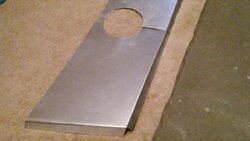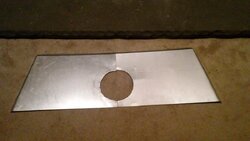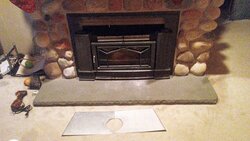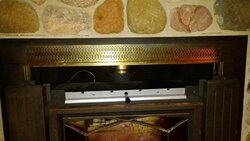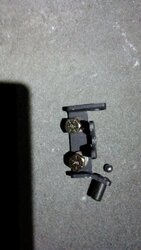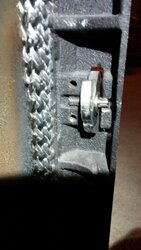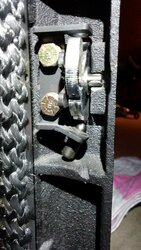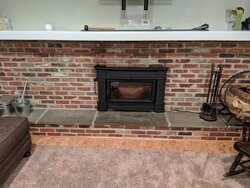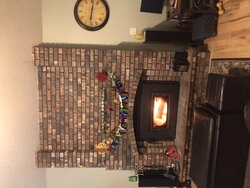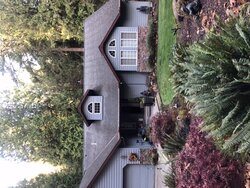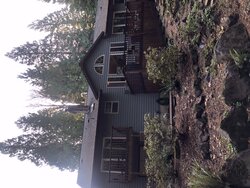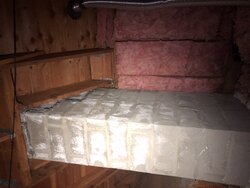After some colder nights (15F) and not being able to raise the room temp barely with the blower on high, I finally broke down and put up a block off plate. Will see how it goes tonight! With the oversized cast faceplate, was easy to lift the top piece off and had enough access with a right-angle drill. The outer diameter of the liner when it comes into the stove is 6", shouldn't it be more if the liner is insulated? I will know more in the spring when I clean the liner. I paid for an insulated liner.
The Regency CI2600 & CI2700 operation thread
- Thread starter Heizer
- Start date
-
Active since 1995, Hearth.com is THE place on the internet for free information and advice about wood stoves, pellet stoves and other energy saving equipment.
We strive to provide opinions, articles, discussions and history related to Hearth Products and in a more general sense, energy issues.
We promote the EFFICIENT, RESPONSIBLE, CLEAN and SAFE use of all fuels, whether renewable or fossil.
You are using an out of date browser. It may not display this or other websites correctly.
You should upgrade or use an alternative browser.
You should upgrade or use an alternative browser.
There is roxul in the damper area, but I may add more in between the block-off and the damper area, and maybe some rope gasket to fill in any small gaps. Heat output was about the same as usual, no major improvement.  20-24F at night, house was 71F between 9pm-4am or so. Only 6 or 7 hours of heat with blower on high. Couldn't get the stove room above 72F.
20-24F at night, house was 71F between 9pm-4am or so. Only 6 or 7 hours of heat with blower on high. Couldn't get the stove room above 72F.
I looked at the cap on the roof, and the top plate and cap were labeled as olympic forever flex 5.5". Does that mean the liner is 5.5?? Outer diameter where it comes into the stove is 6". Label on the liner itself is burnt and unreadable. I checked the CI2600 manual, it's ok to run 5.5, but I don't know why my installer wouldn't have done 6". If I take the top cap off, will I be able to tell if it's blanket wrapped or pre-insulated?
Update: According to this website's diameter listings, I'd guess I have a 5.5" uninsulated liner, but perhaps blanket wrapped. May be really hard to find out looking at the wrapping instructions.
https://chimneysweeponline.com/foreverflex.htm
https://chimneysweeponline.com/ffwrap.htm
 20-24F at night, house was 71F between 9pm-4am or so. Only 6 or 7 hours of heat with blower on high. Couldn't get the stove room above 72F.
20-24F at night, house was 71F between 9pm-4am or so. Only 6 or 7 hours of heat with blower on high. Couldn't get the stove room above 72F.I looked at the cap on the roof, and the top plate and cap were labeled as olympic forever flex 5.5". Does that mean the liner is 5.5?? Outer diameter where it comes into the stove is 6". Label on the liner itself is burnt and unreadable. I checked the CI2600 manual, it's ok to run 5.5, but I don't know why my installer wouldn't have done 6". If I take the top cap off, will I be able to tell if it's blanket wrapped or pre-insulated?
Update: According to this website's diameter listings, I'd guess I have a 5.5" uninsulated liner, but perhaps blanket wrapped. May be really hard to find out looking at the wrapping instructions.
https://chimneysweeponline.com/foreverflex.htm
https://chimneysweeponline.com/ffwrap.htm
Last edited:
Yes, as long as it is fully seasoned. It will burn hot and longHave two CI2600 on their way. Can I burn Hedge in these inserts?
TUOWL
New Member
I have been looking into installing the block off plate and it looks like 85% of the job is getting access to the area to install it. Does anyone have any tips on best practices to get the insert out or gain access to the area? I have the large faceplate behind it which looks like all i need to do is slip that off and i can reach my hands in there, except it wont move it feels like without pulling out the insert first.
I took the block off plate to the nth degree. Mineral wool above the block off plate, with the installer's insulation still above in the damper area. Rope gasket where the two pieces meet. 600F tape at the perimeter of the block off plate. Mineral wool at the back and sides of the insert, some stuffed above where I could stuff some and it would stay on its own.
Blower on high turned off after 9 hours. That is a new record. I did have a mega round in the stove last night, but due to its size there were only 4 pieces in the stove. Two huge glowing chunks still there after 9 hours. Usually after 6 hours it's all ash and blower is off. Turning the blower on high manually still getting decent heat. I do not believe the furnace ran all night. So not having a fully insulated and sealed block off plate does make a difference.
Was it worth it? I suppose. Probably took 8 hours of work spread across a few nights.
Blower on high turned off after 9 hours. That is a new record. I did have a mega round in the stove last night, but due to its size there were only 4 pieces in the stove. Two huge glowing chunks still there after 9 hours. Usually after 6 hours it's all ash and blower is off. Turning the blower on high manually still getting decent heat. I do not believe the furnace ran all night. So not having a fully insulated and sealed block off plate does make a difference.
Was it worth it? I suppose. Probably took 8 hours of work spread across a few nights.
I have been looking into installing the block off plate and it looks like 85% of the job is getting access to the area to install it. Does anyone have any tips on best practices to get the insert out or gain access to the area? I have the large faceplate behind it which looks like all i need to do is slip that off and i can reach my hands in there, except it wont move it feels like without pulling out the insert first.
No matter what advice you get here, read through the manual thoroughly. It goes over all of this. I have the oversized cast faceplate. You have to unthread and remove the bypass rod, then the top piece lifts out. It's 80 lbs or so, you want one hand at the top of one side, one hand below. If you open the door, you can get a hand to one side near the bypass rod hole. Wiggle it back and forth, front to back. You can get a feel for the size of the top piece. Also watch out for the material behind the top piece, easy to scratch. I put cardboard behind, then pull up. If you have the insert fully shoved into the fireplace, it may be binding against the material behind the top piece. You'll have to pull the stove out a small amount. Slide the bottom piece out on the rails, remove, then try to pull from there.
TUOWL
New Member
No matter what advice you get here, read through the manual thoroughly. It goes over all of this. I have the oversized cast faceplate. You have to unthread and remove the bypass rod, then the top piece lifts out. It's 80 lbs or so, you want one hand at the top of one side, one hand below. If you open the door, you can get a hand to one side near the bypass rod hole. Wiggle it back and forth, front to back. You can get a feel for the size of the top piece. Also watch out for the material behind the top piece, easy to scratch. I put cardboard behind, then pull up. If you have the insert fully shoved into the fireplace, it may be binding against the material behind the top piece. You'll have to pull the stove out a small amount. Slide the bottom piece out on the rails, remove, then try to pull from there.
Thank you I had it all apart I think I just have to pull it out a little but I was little afraid to just start pulling on it without knowing what I was doing. Have you tracked how hot the immediate room the insert is in got? Did you see an improvement?
Thank you I had it all apart I think I just have to pull it out a little but I was little afraid to just start pulling on it without knowing what I was doing. Have you tracked how hot the immediate room the insert is in got? Did you see an improvement?
Stove room pretty much only gets to 72F, but burns are longer. House is from 1992, it's tight, good insulation. The stove room has a cathedral ceiling, and if I don't use the ceiling fan slowly going clockwise I bet it would get a little hotter, but the goal is to spread the heat throughout the house. Will keep playing around with it, and I'm going to take a look at the insulation in the attic. There is a ton of loose fill insulation, but always good to look things over.
Help.... the blower won't turn on.
This morning the blower was working fine. I turned it off to reload some wood, and when I closed the door and tried to turn it back on and nothing. I also tried turning it from 'auto' to 'fan', and still nothing.
It's on the same power strip as my tv. I have been noticing lately when I turn the blower on the tv will go black for a second or 2 and then return, which has made me nervous. However, the tv is still working this morning even though the blower isn't. I even tried plugging it into a different plug on the power strip and still no dice.
Does anyone have any advice or insight?
This morning the blower was working fine. I turned it off to reload some wood, and when I closed the door and tried to turn it back on and nothing. I also tried turning it from 'auto' to 'fan', and still nothing.
It's on the same power strip as my tv. I have been noticing lately when I turn the blower on the tv will go black for a second or 2 and then return, which has made me nervous. However, the tv is still working this morning even though the blower isn't. I even tried plugging it into a different plug on the power strip and still no dice.
Does anyone have any advice or insight?
GA Wood Burner
Member
I haven't tried yet but it doesn't appear that hard to get too or out, at least on the CI2600. You may want to call Regency or your installer first and find out if its 110V or some other voltage. If its 110, maybe you could remove it, put it on a work bench and apply pwr, being very careful of course, to see if it'll spin at all. Is it still under warranty?Help.... the blower won't turn on.
This morning the blower was working fine. I turned it off to reload some wood, and when I closed the door and tried to turn it back on and nothing. I also tried turning it from 'auto' to 'fan', and still nothing.
It's on the same power strip as my tv. I have been noticing lately when I turn the blower on the tv will go black for a second or 2 and then return, which has made me nervous. However, the tv is still working this morning even though the blower isn't. I even tried plugging it into a different plug on the power strip and still no dice.
Does anyone have any advice or insight?
killercut
New Member
Hi everyone. My Cat is starting to look like an animal was chewing at it in the middle. There are also pieces of it on the guard. Why would that happen? Is the cat bad now? I still get it to glow.... But it does stop glowing after the fire burns down a bit and the wood is all black and starting to ash significantly, about an hour or 2, maybe 3, into the burn.
I am burning 3-4 loads a day and have the air damper around the middle, otherwise I wouldn't get enough heat and there would be too many coals and it would take too long between loads to get decent heat output, also my glass does not get black at all with the air damper at or above the middle. Could it have absorbed some moisture during the off season and when I started up the stove in the mid-late fall that moisture started damaging it?
Also Grisu posted this in the old thread: Proper burning practice like closing the bypass on time to avoid flame exposure of the cat.
What does that mean? If the fireplace is full of wood and it is burning isn't the flame going to go to the cat no matter what? The flame is what actually gets my Cat to glow, sometimes even before I push in the bypass rod... I usually have to get the fire pretty big before I push in the bypass otherwise it dies down and the cat wont glow. My thermometer went bad so I am burning by what the flames look like for the last month. Stove was installed this time last year. Burned 2 cords last winter and 2 cords already this season. The wood I am burning now may be a little wetter than it should be (my first 2 cords this season were good, the next 2 cords I have now are a little wetter (stacked too late)) , but I try to reload when there are a lot of coals and push in the bypass when most or all of the wood is black. It takes much longer for me to be able to push in the bypass (over 30 min), before I was able to close it within 5 minutes after a reload with a lot of hot coals sometimes, fire would get big fast, and I would need to close it so I can lower the air damper faster. Now I have to wait ~10 minutes to lower the air damper after pushing in the bypass and then I turn the fan on, if I do it too soon fire dies down and cat stops glowing...
I am burning 3-4 loads a day and have the air damper around the middle, otherwise I wouldn't get enough heat and there would be too many coals and it would take too long between loads to get decent heat output, also my glass does not get black at all with the air damper at or above the middle. Could it have absorbed some moisture during the off season and when I started up the stove in the mid-late fall that moisture started damaging it?
Also Grisu posted this in the old thread: Proper burning practice like closing the bypass on time to avoid flame exposure of the cat.
What does that mean? If the fireplace is full of wood and it is burning isn't the flame going to go to the cat no matter what? The flame is what actually gets my Cat to glow, sometimes even before I push in the bypass rod... I usually have to get the fire pretty big before I push in the bypass otherwise it dies down and the cat wont glow. My thermometer went bad so I am burning by what the flames look like for the last month. Stove was installed this time last year. Burned 2 cords last winter and 2 cords already this season. The wood I am burning now may be a little wetter than it should be (my first 2 cords this season were good, the next 2 cords I have now are a little wetter (stacked too late)) , but I try to reload when there are a lot of coals and push in the bypass when most or all of the wood is black. It takes much longer for me to be able to push in the bypass (over 30 min), before I was able to close it within 5 minutes after a reload with a lot of hot coals sometimes, fire would get big fast, and I would need to close it so I can lower the air damper faster. Now I have to wait ~10 minutes to lower the air damper after pushing in the bypass and then I turn the fan on, if I do it too soon fire dies down and cat stops glowing...
Last edited:
I have reached contentment. 76F in the stove room and it's -2F outside.
30% blockoff plate, sealing, insulation in fireplace
20% added R-13 fiberglass on top of 13" blown insulation in attic
50% N/S loading
=100%
Congratulations! It takes a lot of work before reaching contentment... took me almost 2 months after almost giving up several times!
GA Wood Burner
Member
I have a question about the CI2600 catalyst temperature that might be better suited to the more seasoned (no pun intended) wood burning veteran but I would appreciate input from anyone. I know Regency recommends not closing the catalyst bypass until the fire temp has reached 500°F or more but is there a low end temp. at which the bypass should be opened. The reason I ask is that without fail when I come out in the morning to get things going again the temp is always in the 400° (350-450) range. Will that low temp. damage the catalyst? We're about four months in and so far the catalyst looks ok from what I can tell but would just like to avoid any premature damage if possible. Thanks.
Woody Stover
Minister of Fire
"Flame impingement" happens when flames hit the face of the cat, and cause the scooping you see. I don't know your stove construction butf it is relatively easy for flames to get to the cat, you should cut back the air a couple minutes before you close the bypass so that flames don't reach the face of the cat. This can be a problem if your wood is wet since you have to burn hotter to keep the wood going.Proper burning practice like closing the bypass on time to avoid flame exposure of the cat.
What does that mean? If the fireplace is full of wood and it is burning isn't the flame going to go to the cat no matter what? The flame is what actually gets my Cat to glow, sometimes even before I push in the bypass rod... I usually have to get the fire pretty big before I push in the bypass otherwise it dies down and the cat wont glow. My thermometer went bad so I am burning by what the flames look like for the last month. Stove was installed this time last year. Burned 2 cords last winter and 2 cords already this season. The wood I am burning now may be a little wetter than it should be
Anyone ever have the handle go limp? I'm awaiting the replacement part via warranty. I've bent the bracket back in a vise and it's back to being functional. I've removed 2 shims and the door handle is pretty tight to close, but otherwise I wasn't passing the dollar bill test. Stove has been used for only this past winter season.
Attachments
JRFarmer
Member
Howdy folks. I just got the 2020 model CI2600 stove installed last month... they're calling it the "HI500" now. Loving it so far, and I can't wait for the cold weather.
My only disappointment so far is the shallow fire box (but I do love the appearance of this flush mount stove). All my cord wood is 18-20", so I always have to load them east-west. I'm going to spend some time with my miter saw this weekend cutting a bunch of logs to 10" so I can load them north-south and fill the firebox for a long burn.
Anybody know anything about the thermocouple and temperature monitor that comes with this stove? I'd love to replace the monitor with a Raspberry PI or similar and record hours of temperature data. Anybody got any hints for this?
My only disappointment so far is the shallow fire box (but I do love the appearance of this flush mount stove). All my cord wood is 18-20", so I always have to load them east-west. I'm going to spend some time with my miter saw this weekend cutting a bunch of logs to 10" so I can load them north-south and fill the firebox for a long burn.
Anybody know anything about the thermocouple and temperature monitor that comes with this stove? I'd love to replace the monitor with a Raspberry PI or similar and record hours of temperature data. Anybody got any hints for this?
Attachments
Very cool. I know the CI2700 is out, but didn't know they revved the name to HI500 for the Hampton faceplate models. East/west isn't all that bad. If you remove the andirons, what is the depth? The CI2600/HI400 is just about 17" depth, so I cut to 16" and can do North/south. The temperature monitor will work without a fire going, it will just be room temperature. There are two pins that are inserted into the electronic device. I'd image you could hook up a multimeter/Pi to the pins from the probe and figure out how to measure.Howdy folks. I just got the 2020 model CI2600 stove installed last month... they're calling it the "HI500" now. Loving it so far, and I can't wait for the cold weather.
My only disappointment so far is the shallow fire box (but I do love the appearance of this flush mount stove). All my cord wood is 18-20", so I always have to load them east-west. I'm going to spend some time with my miter saw this weekend cutting a bunch of logs to 10" so I can load them north-south and fill the firebox for a long burn.
Anybody know anything about the thermocouple and temperature monitor that comes with this stove? I'd love to replace the monitor with a Raspberry PI or similar and record hours of temperature data. Anybody got any hints for this?
JRFarmer
Member
Very cool. I know the CI2700 is out, but didn't know they revved the name to HI500 for the Hampton faceplate models. East/west isn't all that bad. If you remove the andirons, what is the depth? The CI2600/HI400 is just about 17" depth, so I cut to 16" and can do North/south. The temperature monitor will work without a fire going, it will just be room temperature. There are two pins that are inserted into the electronic device. I'd image you could hook up a multimeter/Pi to the pins from the probe and figure out how to measure.
I didn't know they changed the stove model number to CI2700. Our installer just told us they would get the new 2020 model, and it was updated for the 2020 EPA standards. He called it "the 500".
I think the firebox has the same dimensions as the CI2600, I think our stove came with a CI2600 manual, I'll have to check when I get home.
Is that the consensus on the andirons, then? Just remove them? So far they've only gotten in my way while trying to spread the coals or clean out out some ash.
JRFarmer
Member
I did a little bit of googling... it looks like the miniature style connector is often associated with Type K thermocouples. That's the assumption, I'll verify it with a multimeter.
Hi everyone, here’s a report and a question for my CI2600.
This is our third winter with the CI2600, bought it new February of 2018. Live in western Oregon, so somewhat mild winters.
In our 2,500 sq ft house, the stove does a darn good job heating the house. Once the daytime highs drop below about 35, then the stove can’t quite keep up. But that’s okay, we use the gas furnace to keep the house from getting below 62 at night. With that supplementare heat, the wood stove can keep up and we leave the wood heat!
I usually can’t get much past a 4-6 hour burn. I’m using mostly softwoods like fir and hemlock. Doing some experimentation and reading to see if I can extend this.
My main issue though is getting smoke back into the house. It’s a problem no matter what cycle we’re in, whether starting a fire, or reloading a hot bed of coals, or anything in between. It’s not a crazy amount of smoke, but definitely enough to stink up the whole house if we leave the door open for more than 10-15 seconds.
Is anybody else experiencing smoke coming back into the house?
The chimney from top of wood stove to the cap is around 18 feet. I provided some pictures. The bottom six feet of chimney is between the walls, the next 6-8 feet of chimney is in the crawl space, and the last 5-6 feet is above the roof line. This morning ran a hot fire until around 3 or 4 am. Around 8:00am I went into the crawl space to take these pictures, and the cinder block chimney had spots slightly warm to the touch.
Thanks!
This is our third winter with the CI2600, bought it new February of 2018. Live in western Oregon, so somewhat mild winters.
In our 2,500 sq ft house, the stove does a darn good job heating the house. Once the daytime highs drop below about 35, then the stove can’t quite keep up. But that’s okay, we use the gas furnace to keep the house from getting below 62 at night. With that supplementare heat, the wood stove can keep up and we leave the wood heat!
I usually can’t get much past a 4-6 hour burn. I’m using mostly softwoods like fir and hemlock. Doing some experimentation and reading to see if I can extend this.
My main issue though is getting smoke back into the house. It’s a problem no matter what cycle we’re in, whether starting a fire, or reloading a hot bed of coals, or anything in between. It’s not a crazy amount of smoke, but definitely enough to stink up the whole house if we leave the door open for more than 10-15 seconds.
Is anybody else experiencing smoke coming back into the house?
The chimney from top of wood stove to the cap is around 18 feet. I provided some pictures. The bottom six feet of chimney is between the walls, the next 6-8 feet of chimney is in the crawl space, and the last 5-6 feet is above the roof line. This morning ran a hot fire until around 3 or 4 am. Around 8:00am I went into the crawl space to take these pictures, and the cinder block chimney had spots slightly warm to the touch.
Thanks!
Attachments
Similar threads
- Replies
- 30
- Views
- 1K
- Replies
- 3
- Views
- 631
- Replies
- 2
- Views
- 568
- Replies
- 10
- Views
- 2K


